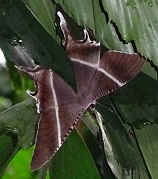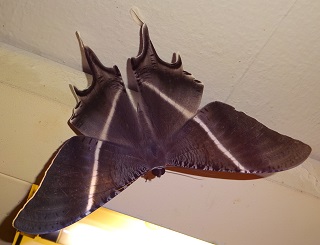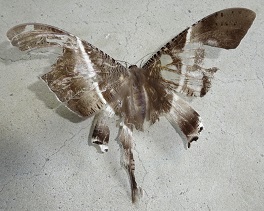| Home | Nature Weekly Index |
25 May 2014 | Tropical Swallowtail Moth | Lyssa zampa |
 Yes, it is the season of the
Tropical Swallowtail Moth (Lyssa zampa). You may
have read the recent news on the appearance of many large dark brown moth, which has a white strip across its wings, across
Singapore.
Yes, it is the season of the
Tropical Swallowtail Moth (Lyssa zampa). You may
have read the recent news on the appearance of many large dark brown moth, which has a white strip across its wings, across
Singapore.
The first appearance of this moth caught my attention in a park nearby last Saturday but it escape so fast to another location
on a Mango Tree (Mangifera indica) with thick foliage that I was not
able to see clearly the flying object. All I could figure out was that it was a really big moth that I had not seen before.
While moving into a close vegetation in the same park, I saw another one of this large flying object dashed across my path
and landed on the leaf of a Fishtail Palm (Caryota mitis). This time
round, I was able to see the moth but from a distance since the position that it landed was quite high up on the tree.
 My camera zoom was put to the test and the picture, as expected, did not achieve the quality desired. However, it was good
enough for me to have an idea on how this large moth looked like. Little did I know that I was about to see more of them in
the next few days.
My camera zoom was put to the test and the picture, as expected, did not achieve the quality desired. However, it was good
enough for me to have an idea on how this large moth looked like. Little did I know that I was about to see more of them in
the next few days.
Two days later on a Monday morning while I was going about my routine watering of the potted plants, I finally get to see the moth at close range. One specimen was fluttering its wings along the corridor of my front door and finally decided to take a break near a light tube located at the ceiling of the corridor. I was quite excited and rushed into the house to get my camera. Fortunately, the moth remained undisturbed and I got the pictures that I wanted.
 It was not to too difficult to find the identity of this moth from the Internet although I did not know anything about this
moth until this sighting. Apparently, this moth was rank number 2 in term of body size in Singapore. The number 1 position
has been taken up by the
Atlas Moth (Attacus atlas).
It was not to too difficult to find the identity of this moth from the Internet although I did not know anything about this
moth until this sighting. Apparently, this moth was rank number 2 in term of body size in Singapore. The number 1 position
has been taken up by the
Atlas Moth (Attacus atlas).
Ecologist N. Sivasothi (a.k.a. Otterman) from the National University of Singapore has been tracking the seasonal appearance of this month here since 2005. The moth subsequently showed up in May 2009, June 2010 and the most recent update in this month. The larvae of this moth has been reported to feed on Endospermum and other members of the rubber tree family (Euphorbiaceae). So far, only one Endospermum species has been recorded in the forest here.
Over the week including this morning, I spotted at least 8 of the moths, mostly around the block of flat that I am staying. Although the moth appeared to be very alert in the vegetation, it seemed not to be so when it landed in open area. One of them has been staying on the wall along a corridor for the last 2 days. Both fresh and old specimens were seen.
Update: 28 June 2014
I found 2 short reports on this moth published on 6 June in the Singapore Biodiversity Records; one with a mating pair and the other on its caterpillars. The caterpillar report confirmed that the hostplant is indeed Endospermum diadenum (Bulan-bulan Tree). I still saw a few of the moths at the park today.